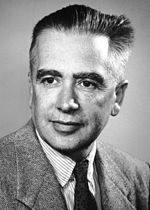How to Pronounce Emilio Segrè
#50
Most Popular
Boost
Feb 01, 1905 Tivoli, Lazio, Italy Died on 22 Apr 1989 (aged 84)
Italian physicist and Nobel laureate
AquariusEmilio Segrè, Date of Birth, Place of Birth, Family, Facts, Age, Net Worth, Biography and More in FamedBorn.com

Italian physicist and Nobel laureate
Aquarius